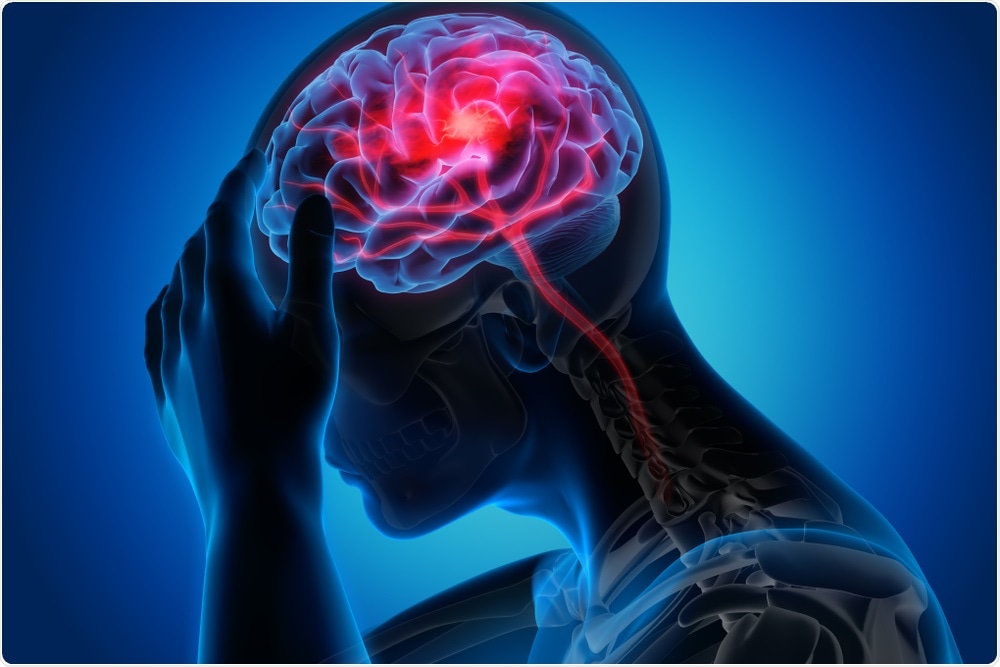This tells us nothing useful. NOTHING TO TREAT THESE STROKES,NOTHING AT ALL.
My doctor told me I had a bunch of white matter hyperintensities but never showed me them or explained what I could do about them. He was totally useless.
New genetic evidence points to novel therapies for “silent” stroke
According to a study sponsored by the British Heart Foundation (BHF) and published in The Lancet Neurology journal, researchers have discovered new genetic clues in individuals who had experienced small but often apparently “silent” strokes that are hard to treat and can be a significant cause of vascular dementia.

Stroke. Image Credit: peterschreiber.media/Shutterstock.com
The researchers detected changes in 12 genetic regions in the DNA of individuals who had experienced a lacunar stroke—a form of stroke-induced by the weakening of small blood vessels found deep inside the brain.
But over time, the damage caused to the blood vessels and the resulting interruption to blood flow may result in long-term disability, causing difficulties with memory, thinking, walking, and finally leading to dementia.
There are few medications that have been demonstrated to treat or prevent lacunar strokes. The affected blood vessels measure less than a millimeter across, and a lacunar stroke can occur without the individual being aware of it. Generally, it is not until a person has had a number of these strokes and begins to show symptoms of dementia that he or she realizes that something is wrong.
So far, only a single genetic flaw has been linked to lacunar strokes. But after more than 10 years of study, Professor Hugh Markus and his research team from the University of Cambridge, in collaboration with scientists from across the world, now believe that their genetic discovery could be crucial for identifying the much-needed therapies for vascular dementia and lacunar stroke.
The genetic code of 7,338 patients who had a lacunar stroke, was scanned and compared with the genetic code of 254,798 people who did not. The researchers recruited participants from Australia, South America, the United States, and Europe after they had a CT or MRI brain scan at a hospital.
Many of the 12 genetic regions associated with lacunar strokes were found to be involved in the regulation of the neurovascular unit—the portion of the brain that divides the blood vessels from the brain and makes sure that nerves work normally.
Such genetic variations are assumed to make the tiny blood vessels “leakier,” allowing harmful substances to reach the brain, which means that signals moving around the brain slow down or stop altogether.
The researchers have now planned to test whether novel therapies will correct these defects in brain cells in laboratory settings. The team is hoping to initiate human clinical trials in the next decade.
The new study also emphasized that type 2 diabetes, high blood pressure, and a history of smoking are all causally linked to an elevated risk of lacunar stroke, detecting things that can be addressed instantly.
These small and often silent lacunar strokes have gone under the radar for a long time, and so we haven't been able to treat patients as well as we'd like to. Although small, their consequences for patients can be enormous. They cause a quarter of all strokes and they are the type of stroke which is most likely to lead to vascular dementia.”
Hugh Markus, Professor and BHF-Funded Researcher, University of Cambridge
Professor Markus, who is also the leader of the study and a neurologist at the University of Cambridge, added, “We now plan to use this new genetic blueprint as a springboard to develop much-needed treatments to prevent lacunar strokes from occurring in the first place and to help stave off dementia.”
“Genetics offers one of the few ways we can discover completely new insights into what causes a disease such as lacunar stroke. It is only by better understanding of what causes the disease that we will be able to develop better treatments,” stated Dr Matthew Traylor, the first author of the study from the Queen Mary University of London.
This is the most extensive genetic search to date which truly gets to grips with what cause lacunar strokes. These findings are a significant leap forward and we now have a much greater understanding of the genetics and biology behind what causes the small blood vessels deep in the brain to become diseased.”
Sir Nilesh Samani, Professor, Cardiologist, and Medical Director, British Heart Foundation
“Lacunar strokes affect around 35,000 people in the UK each year. This research provides real hope that we can prevent and treat this devastating type of stroke much better in the future,” concluded Professor Samani.
Traylor, M., et al. (2021) Genetic basis of lacunar stroke: a pooled analysis of individual patient data and genome-wide association studies. The Lancet Neurology. doi.org/10.1016/S1474-4422(21)00031-4.
No comments:
Post a Comment